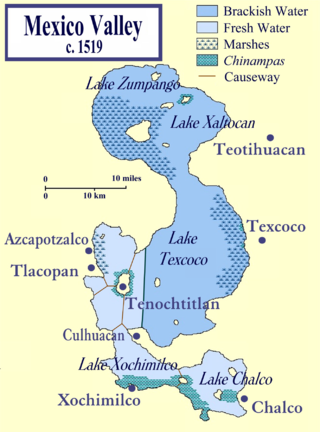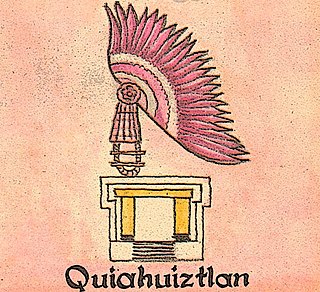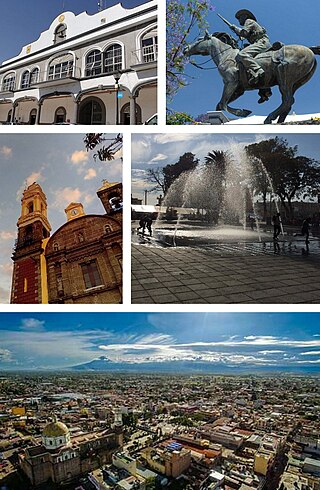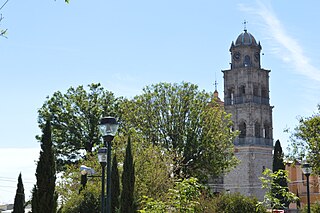Tlaxcala is a Mexican state.
Tlaxcala may also refer to:
- Tlaxcala (city), the capital city of the Mexican state of Tlaxcala and seat of the municipality
- Tlaxcala Territory 1824–1857
- Tlaxcala (Nahua state), the pre-Columbian city and state
Tlaxcala is a Mexican state.
Tlaxcala may also refer to:

Tlaxcala, officially Tlaxcala de Xicohténcatl, is the capital city of the Mexican state of Tlaxcala and seat of the municipality of the same name. The city did not exist during the pre-Hispanic period but was laid out by the Spanish as a center of evangelization and governance after the Spanish conquest of the Aztec Empire. The city was designated as a diocese but eventually lost that status to Puebla as its population declined. The city still has many of its old colonial structures, including the former Franciscan monastery, and newer civic structures like the Xicohtencatl Theatre.

The Nahua people, also academically referred to as Pipil, are an indigenous group of Mesoamerican people inhabiting the western and central areas of present-day El Salvador. Although very few speakers are now left, they speak the Nawat language, which belongs to the Nahuan language branch. Indigenous accounts recorded by Spanish chronicler Gonzalo Francisco de Oviedo suggest that the Nahuas of El Salvador migrated from present-day Mexico to their current locations beginning around the 8th century A.D. As they settled in the area, they founded the city-state of Kuskatan, which was already home to various groups including the Lenca, Xinca, Ch'orti', and Poqomam.

The Nahuas are a group of the indigenous people of Mexico, El Salvador, Guatemala, Honduras, and Nicaragua. They comprise the largest indigenous group in Mexico and second largest in El Salvador. The Mexica (Aztecs) were of Nahua ethnicity, and the Toltecs are often thought to have been as well, though in the pre-Columbian period Nahuas were subdivided into many groups that did not necessarily share a common identity.

Tlaxcala, officially the Free and Sovereign State of Tlaxcala, is one of the 32 states which comprise the Federal Entities of Mexico. It is divided into 60 municipalities and the capital city is Tlaxcala City.

The Aztec Empire or the Triple Alliance was an alliance of three Nahua city-states: Mexico-Tenochtitlan, Tetzcoco, and Tlacopan. These three city-states ruled that area in and around the Valley of Mexico from 1428 until the combined forces of the Spanish conquistadores and their native allies who ruled under Hernán Cortés defeated them in 1521.
The Tlaxcalans, or Tlaxcaltecs, are a Nahua people who live in the Mexican state of Tlaxcala.

The Spanish conquest of the Aztec Empire, also known as the Conquest of Mexico or the Spanish-Aztec War (1519–21), was one of the primary events in the Spanish colonization of the Americas. There are multiple 16th-century narratives of the events by Spanish conquistadors, their indigenous allies, and the defeated Aztecs. It was not solely a contest between a small contingent of Spaniards defeating the Aztec Empire but rather the creation of a coalition of Spanish invaders with tributaries to the Aztecs, and most especially the Aztecs' indigenous enemies and rivals. They combined forces to defeat the Mexica of Tenochtitlan over a two-year period. For the Spanish, the expedition to Mexico was part of a project of Spanish colonization of the New World after twenty-five years of permanent Spanish settlement and further exploration in the Caribbean.

Apizaco is a city in Apizaco Municipality located near the geographic center of the Mexican state of Tlaxcala, approximately 25 minutes by car from the state's capital city of Tlaxcala. The city gets its name from the Nahuatl language words "ātl" (water), "pitzāhuac" (thin), and the suffix "co" (place), forming "Āpitzāco", or roughly "thin water place". Those seeking to reach the port of Veracruz by railroad from Mexico City must travel through Apizaco. The city began because of its location on this railroad.

Tlaxcala was a pre-Columbian city and state in central Mexico.

Toribio of Benavente, O.F.M., also known as Motolinía, was a Franciscan missionary who was one of the famous Twelve Apostles of Mexico who arrived in New Spain in May 1524. His published writings are a key source for the history and ethnography of the Nahuas of central Mexico in the immediate post-conquest period as well as for the challenges of Christian evangelization. He is probably best known for his attacks on the Dominican defender of the rights of the indigenous peoples, Bartolomé de las Casas, who criticized the Conquest. Though agreeing with Las Casas's criticism of the abuses of the conquistadors, he did not agree with the whole sale condemnation of the Spanish Conquest, as well as his criticisms of the Franciscan practices of baptism en masse of the indigenous people of the new world. Due to these differences he went on to vilify Las Casas.

Xaltocan was a pre-Columbian city-state and island in the Valley of Mexico, located in the center of Lake Xaltocan, part of an interconnected shallow lake system which included Lake Texcoco; this place is now inside the village of San Miguel Jaltocan in Nextlalpan, State of Mexico. The site was originally settled by the Otomi people but following a war in the late fourteenth century where the Otomi were defeated by an alliance of Tepanecs and Mexica the Otomi were driven off the island and relocated to Otumba, Metztitlan and Tlaxcala. The island of Xaltocan was then resettled by Nahuatl speakers. The name can mean either of two things in the Nahuatl language: either 'sandy ground of spiders' or 'where it is planted on the sand'.
Charles Gibson was an American ethnohistorian who wrote foundational works on the Nahua peoples of colonial Mexico and was elected President of the American Historical Association in 1977.

Quiahuiztlan was one of the four altepetl (polities) that made up the confederation of Tlaxcala. It is located in the modern city of Tlaxcala, Tlaxcala State, Mexico.

San Isidro Buensuceso or San Isidro Buen Suceso is a town in the municipality of San Pablo del Monte, Tlaxcala, Mexico, on the southern slope of La Malinche volcano. The town is named after Saint Isidore the Laborer, whose feast day is celebrated on May 15 each year.

Cuautlancingo Municipality is a town and municipality in Puebla, south-eastern Mexico. It is part of the Metropolitan area of Puebla. The town is bordered on the north by the state of Tlaxcala, Tlaxcala, east to the municipality of Tlaxcala and the city of Puebla, to the south with the municipality of San Pedro Cholula and Puebla and west by the municipality of Coronango.

Zacatlán Municipality is a municipality in Puebla in south-eastern Mexico. Its administrative centre is the city of Zacatlán.

Zacatelco is a city and capital of Zacatelco municipality located south of the state of Tlaxcala. According to the population census conducted by the National Institute of Statistics and Geography 2010, the city has a population of 38.466 people, it is the sixth most populous city in the state and is part of the Metropolitan area of Puebla. The city is also head of the third electoral district of Tlaxcala.

Ixtenco is located in Ixtenco Municipality in the southeast of the Mexican state of Tlaxcala. It is a traditional Otomi community, which has conserved its agricultural economic base and various traditions. However, it is one of the poorest and least populated of the state's municipalities. The town's main landmark is the San Juan Bautista Parish and the municipality contains the remains of colonial era haciendas. The municipality lies on an old lava flow from the nearby La Malinche Volcano, which provides its volcanic soil, but because of the destruction of forests and overgrazing, erosion is a significant problem.

Domingo Arenas was a Mexican revolutionary from the state of Tlaxcala. Born in the Nahua community of Zacatelco, he was raised as a farmer and worked as a shepherd, bread salesman and factory worker. At the beginning of the Mexican Revolution he join the forces of Francisco I. Madero, and at the fall of Madero joined the Zapatistas against the Constitutionalists by signing the Plan de Ayala. Discontented with how the Zapatistas treated the locals of Tlaxcala, he switched to support Venustiano Carranza against Emiliano Zapata. In 1916 he was killed by Zapatista general Gildardo Magaña in a botched parlay. At the height of their influence the Arenistas controlled most of Tlaxcala and Southern Puebla. The municipality of Domingo Arenas is named after him.

Tlaxco is a municipality in Tlaxcala, Mexico.